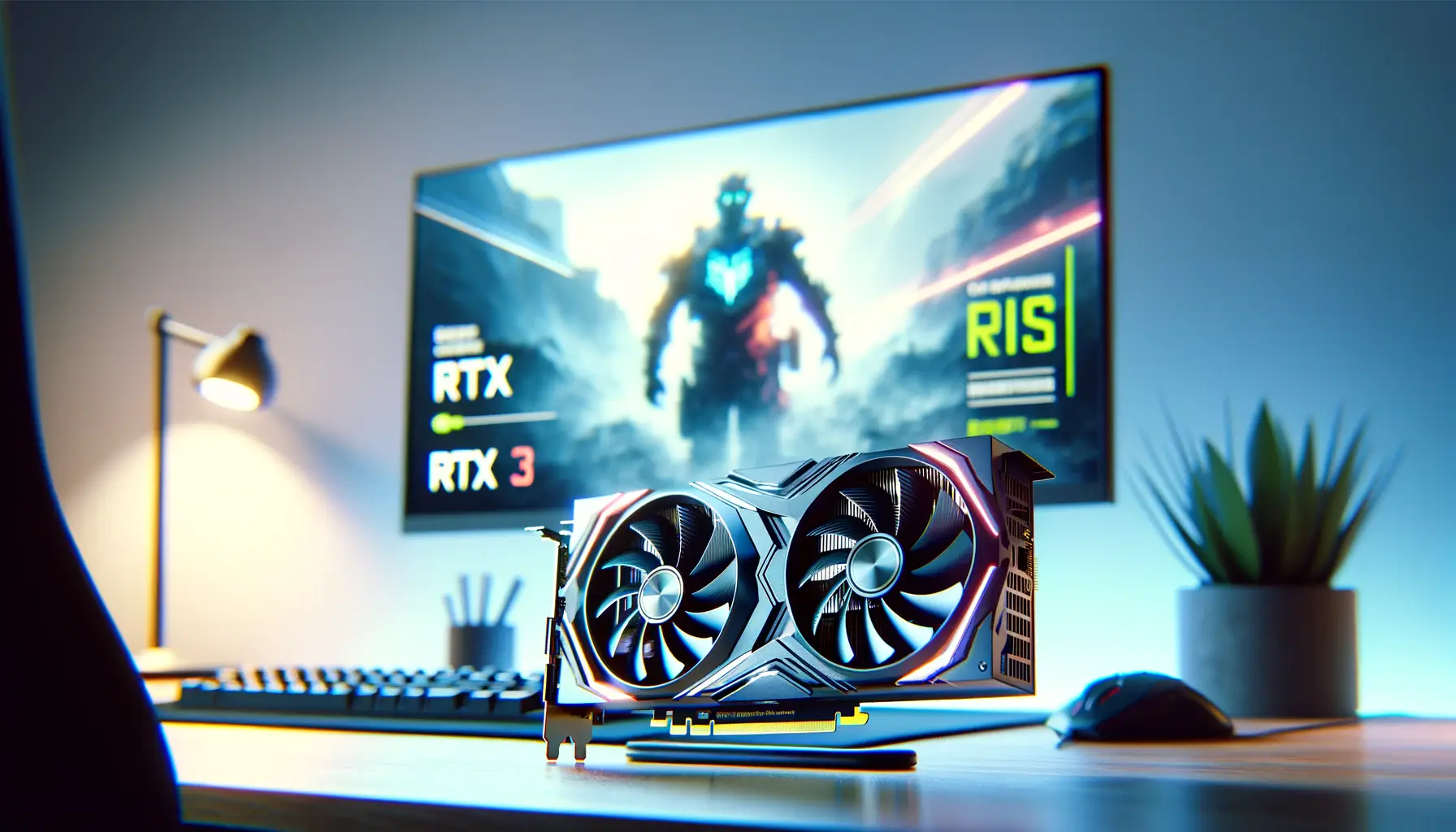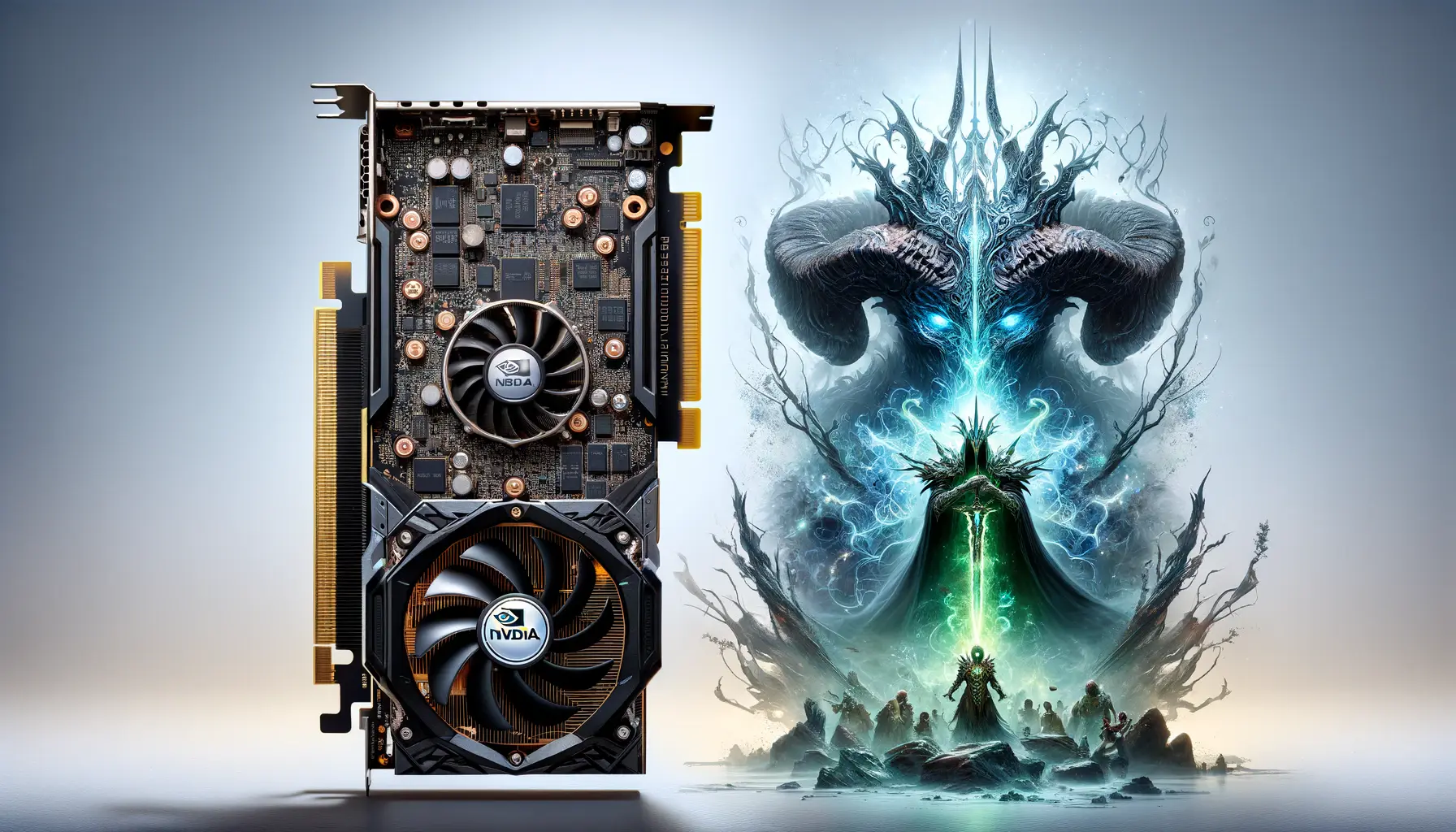Entering the realm of high-fidelity gaming, the quest for achieving the perfect balance between visual quality and performance has always been a paramount challenge for gamers and developers alike.
With the advent of NVIDIA’s RTX 40 series graphics cards, a new horizon in gaming performance has been unveiled, particularly through the integration of Deep Learning Super Sampling (DLSS) 3 technology.
This groundbreaking feature not only promises to elevate the gaming experience to unprecedented levels but also sets a new benchmark for what’s possible in real-time rendering.
DLSS 3, NVIDIA’s latest iteration of AI-driven super sampling, harnesses the power of advanced AI algorithms and the dedicated Tensor Cores found in the RTX 40 series GPUs.
By intelligently generating high-quality frames from lower-resolution images, DLSS 3 enables gamers to enjoy their favorite titles at higher frame rates without compromising on visual fidelity.
This technology is not just an incremental update; it represents a significant leap forward in the pursuit of seamless and immersive gaming experiences.
- Understanding DLSS 3 and Its Impact on Gaming
- Exploring the Benefits of DLSS 3 for Gamers
- DLSS 3 in Action: Real-World Gaming Scenarios
- Optimizing Settings for Maximum Performance with DLSS 3
- Comparing DLSS 3 with Previous Versions
- DLSS 3’s Role in Future Gaming Technologies
- Navigating the Challenges and Considerations of DLSS 3
- Embracing the Future with DLSS 3 on RTX 40 Series
- DLSS 3 on RTX 40 Series: Frequently Asked Questions
Understanding DLSS 3 and Its Impact on Gaming
What is DLSS 3?
At its core, DLSS 3 is a revolutionary technology designed to optimize rendering performance and image quality using artificial intelligence.
Unlike its predecessors, DLSS 3 introduces the concept of Frame Generation, which, in conjunction with AI upscaling, significantly boosts the frames per second (FPS) output.
This is achieved by interpolating additional frames between existing ones, effectively smoothing out gameplay and making high-resolution gaming more accessible.
The magic of DLSS 3 lies in its ability to deliver a smoother gaming experience without the traditional trade-offs associated with higher resolutions and ray tracing.
By leveraging the neural networks trained on NVIDIA’s supercomputers, DLSS 3 predicts and generates frames with astonishing accuracy, ensuring that gamers can enjoy the visual splendor of their games at fluid frame rates.
The Role of RTX 40 Series in Enhancing DLSS 3
The RTX 40 series GPUs are not just hardware upgrades; they are the backbone of DLSS 3’s performance enhancements.
Equipped with more powerful Tensor Cores and a new architecture optimized for AI computations, these GPUs are uniquely capable of handling the complex calculations required for DLSS 3’s Frame Generation.
This synergy between hardware and software unlocks new possibilities for achieving ultra-high frame rates in games that were previously bound by the limitations of traditional rendering techniques.
Furthermore, the RTX 40 series’ support for DLSS 3 opens up new avenues for game developers to push the boundaries of visual quality and performance.
With the heavy lifting handled by DLSS 3, developers can focus on enhancing game aesthetics and complexity, knowing that the technology will ensure a smooth and responsive gaming experience for players.
DLSS 3, with its Frame Generation technology, represents a paradigm shift in gaming performance, making 4K gaming at high frame rates more attainable than ever before.
Exploring the Benefits of DLSS 3 for Gamers
The introduction of DLSS 3 technology in NVIDIA’s RTX 40 series GPUs has been a game-changer for the gaming community.
This innovative feature not only enhances the visual quality of games but also significantly improves performance, allowing gamers to enjoy their favorite titles at higher frame rates and resolutions.
Let’s delve into the myriad benefits that DLSS 3 offers to gamers, highlighting how it transforms the gaming experience.
Enhanced Frame Rates and Smooth Gameplay
One of the most immediate benefits of DLSS 3 is its ability to boost frame rates dramatically.
By generating additional frames, DLSS 3 ensures that gameplay remains smooth and fluid, even in graphically intensive scenarios.
This is particularly beneficial for competitive gamers, where every millisecond counts, and higher frame rates can provide a competitive edge.
- Reduction in latency and input lag, ensuring responsive controls.
- Improved game performance without compromising on visual quality.
- Access to higher resolutions and settings previously unattainable on certain hardware configurations.
Superior Image Quality with AI Upscaling
DLSS 3’s AI-driven upscaling techniques not only enhance performance but also improve image quality.
By intelligently upscaling lower-resolution images, DLSS 3 delivers crisp, clear visuals that rival native high-resolution rendering.
This allows gamers to experience the full graphical fidelity of their games without the need for prohibitively expensive hardware.
- Sharper textures and more detailed environments, bringing game worlds to life.
- Reduction of jagged edges and visual artifacts, resulting in smoother images.
- Dynamic resolution scaling to maintain performance without noticeable drops in quality.
Future-Proofing Gaming Setups
With the rapid pace of technological advancements in gaming, DLSS 3 offers a form of future-proofing for gamers’ setups.
As games continue to demand more from hardware, DLSS 3 ensures that gamers can continue to enjoy new titles at high settings without the need for frequent upgrades.
This sustainability aspect is a significant advantage, making high-end gaming more accessible to a broader audience.
- Longevity of gaming hardware, extending the life of current setups.
- Reduced need for frequent upgrades, offering better value over time.
- Compatibility with a wide range of titles, ensuring gamers can enjoy the latest games at optimal performance.
DLSS 3 is not just a technological marvel; it’s a testament to NVIDIA’s commitment to pushing the boundaries of gaming performance and visual quality. By leveraging AI to enhance both, DLSS 3 sets a new standard for what gamers can expect from their gaming experiences.
DLSS 3 in Action: Real-World Gaming Scenarios
The true prowess of DLSS 3 comes to light when observed in real-world gaming scenarios.
Across various titles, from fast-paced shooters to expansive open-world games, DLSS 3 demonstrates its ability to redefine gaming experiences.
This section explores how DLSS 3 impacts gameplay, visuals, and overall performance in practical gaming situations, offering insights into its transformative effects.
By examining specific case studies and user experiences, we can understand the tangible benefits DLSS 3 brings to the gaming table.
Whether it’s achieving smoother frame rates in action-packed moments or maintaining crisp visuals in densely populated environments, DLSS 3 proves to be an indispensable tool for modern gaming.
Impact on Competitive Gaming
In the realm of competitive gaming, where every frame can make a difference, DLSS 3 shines by providing a smoother and more responsive gaming experience.
Games like “Fortnite” and “Call of Duty: Warzone” have seen noticeable improvements in frame rates, allowing players to react more swiftly to in-game events.
- Enhanced responsiveness and reduced input lag in fast-paced scenarios.
- Stable, high frame rates during intense multiplayer matches.
- Clearer visuals, helping players spot enemies and make split-second decisions.
Exploring Vast Open Worlds
For games that boast expansive open worlds, such as “The Witcher 3” and “Cyberpunk 2077,” DLSS 3 ensures that immersion is never broken by performance drops.
Players can explore these vast environments in stunning detail, with DLSS 3 intelligently balancing performance and visual fidelity.
- Maintained high frame rates while traversing large, detailed game worlds.
- Improved visual clarity and detail, enhancing the exploration experience.
- Reduced performance impact of high-quality settings, allowing for richer game environments.
Revolutionizing Single-Player Narratives
Single-player games with rich narratives and detailed worlds also benefit from DLSS 3’s capabilities.
Titles like “Control” and “Metro Exodus” showcase how DLSS 3 can enhance storytelling through better visuals and smoother gameplay, making every moment more engaging and immersive.
- Seamless transitions between high-action sequences and narrative-driven scenes.
- Enhanced atmospheric effects and lighting, contributing to a more immersive story experience.
- Ability to play at higher resolutions without sacrificing performance, making every detail sharper and more lifelike.
DLSS 3’s impact extends across all genres and styles of gaming, proving its versatility and essential role in modern gaming setups. By delivering unparalleled performance improvements and visual enhancements, DLSS 3 elevates the gaming experience to new heights, regardless of the game being played.
Optimizing Settings for Maximum Performance with DLSS 3
While DLSS 3 significantly enhances gaming performance and visual quality, optimizing game settings is crucial to harness its full potential.
Adjusting various parameters can lead to an even smoother and more visually stunning gaming experience.
This part of the article will guide you through optimizing settings for maximum performance with DLSS 3, ensuring you get the most out of your RTX 40 series GPU.
Understanding the balance between performance and visual fidelity is key when tweaking settings.
DLSS 3 offers different modes tailored to various preferences, allowing gamers to prioritize frame rates or image quality.
Here, we’ll explore how to strike the perfect balance for your gaming needs.
Finding the Right DLSS Mode
DLSS 3 provides several modes, including Quality, Balanced, Performance, and Ultra Performance.
Each mode offers a different balance between image quality and frame rate:
- Quality Mode: Focuses on maximizing visual fidelity while still offering a performance boost.
- Balanced Mode: Offers a middle ground between image quality and performance.
- Performance Mode: Prioritizes frame rate improvements, ideal for competitive gaming.
- Ultra Performance Mode: Maximizes frame rates for high-resolution displays, suitable for 8K gaming.
Adjusting In-Game Graphics Settings
Beyond DLSS settings, adjusting in-game graphics options can further optimize performance.
Lowering or tweaking certain settings can provide additional frame rate boosts without significantly impacting visual quality:
- Reduce shadow quality and ambient occlusion, as these can be performance-intensive.
- Adjust anti-aliasing settings, as DLSS already provides superior anti-aliasing.
- Lower the effects and post-processing quality for better performance in fast-paced scenes.
Utilizing NVIDIA Control Panel Settings
The NVIDIA Control Panel offers additional options to fine-tune your gaming experience.
Adjusting these settings can complement DLSS 3’s performance improvements:
- Set Power Management Mode to “Prefer maximum performance” to ensure your GPU operates at its peak.
- Adjust Texture Filtering Quality to “High performance” for a slight boost in frame rates.
- Enable Low Latency Mode to reduce input lag, especially beneficial in competitive gaming.
Remember, the optimal settings will vary depending on your specific hardware configuration and the games you play. Experimenting with different combinations of DLSS modes and in-game settings is key to finding the perfect setup for your gaming preferences.
Comparing DLSS 3 with Previous Versions
The evolution of NVIDIA’s DLSS technology has been a journey of continuous improvement, with each version bringing significant advancements in performance and image quality.
DLSS 3, the latest iteration, stands as a testament to NVIDIA’s commitment to pushing the boundaries of gaming technology.
This section delves into how DLSS 3 compares to its predecessors, highlighting the strides made in enhancing the gaming experience.
Understanding the progression from DLSS 1.0 to DLSS 3.0 provides insight into the technological leaps NVIDIA has achieved.
Each version has built upon the last, refining the balance between performance gains and visual fidelity, with DLSS 3 representing the pinnacle of this development.
DLSS 1.0: The Foundation
DLSS 1.0 laid the groundwork for AI-based rendering, offering improved frame rates by rendering games at a lower resolution and then upscaling.
While it provided a performance boost, it faced criticism for image quality issues, such as blurriness and loss of detail.
DLSS 1.0 was a bold step forward, but it was clear that refinements were needed to fully realize its potential.
DLSS 2.0: A Significant Leap Forward
DLSS 2.0 addressed many of the shortcomings of its predecessor, introducing a more flexible and efficient AI model.
This version significantly improved image quality, reducing artifacts and blurriness.
It also offered different modes (Quality, Balanced, Performance) to better cater to gamers’ preferences.
DLSS 2.0 was widely praised for its ability to deliver higher frame rates without compromising on visual fidelity, marking a significant leap forward in the technology’s development.
DLSS 3.0: Revolutionizing Game Performance
DLSS 3.0 builds upon the successes of DLSS 2.0, introducing Frame Generation technology alongside AI upscaling.
This addition allows for even higher frame rates by generating additional frames, further smoothing gameplay.
DLSS 3.0 not only enhances performance but also maintains, and in some cases improves, image quality.
It represents the most advanced version of the technology, offering unparalleled improvements in both performance and visual quality.
DLSS 3’s introduction of Frame Generation technology sets it apart from previous versions, offering a new dimension of performance enhancement that redefines the possibilities of real-time rendering in gaming.
DLSS 3’s Role in Future Gaming Technologies
The introduction of DLSS 3 by NVIDIA has not only reshaped the landscape of current gaming performance and visual fidelity but also laid down a foundational stone for the future of gaming technologies.
As we look ahead, the implications of DLSS 3 extend far beyond immediate performance gains, hinting at a future where AI and machine learning play pivotal roles in game development and experience.
This section explores DLSS 3’s potential impact on future gaming technologies and trends.
DLSS 3’s innovative approach to rendering, combining AI-driven frame generation with super-resolution techniques, opens up new avenues for both game developers and hardware manufacturers.
By significantly lowering the hardware requirements for running games at ultra-high settings, DLSS 3 democratizes high-quality gaming, making it accessible to a broader audience.
Enabling More Immersive VR Experiences
Virtual Reality (VR) stands to benefit immensely from DLSS 3’s capabilities.
The technology’s ability to boost frame rates while maintaining high image quality is crucial for VR, where smooth performance is essential to prevent motion sickness and ensure a truly immersive experience.
- Higher frame rates reduce latency, a critical factor in VR responsiveness.
- Improved visual clarity enhances the sense of presence in virtual environments.
- DLSS 3 allows for more detailed and complex VR worlds without compromising performance.
Facilitating Advanced Game Development
For game developers, DLSS 3 offers the opportunity to push the boundaries of game design and visual complexity.
With the performance headroom provided by DLSS 3, developers can incorporate more detailed textures, advanced lighting effects, and complex particle systems, enriching the gaming experience without fearing performance penalties.
- Enables the creation of more visually stunning and immersive game worlds.
- Reduces the performance cost of implementing advanced graphical features.
- Supports the development of more ambitious and graphically intensive games.
Shaping the Future of Gaming Hardware
The efficiency gains from DLSS 3 also have implications for the future design and development of gaming hardware.
By optimizing performance through software, DLSS 3 could lead to a shift in how hardware is designed, prioritizing AI and machine learning capabilities alongside traditional GPU power.
- Potential for more energy-efficient GPUs that rely on AI optimizations.
- Increased focus on AI and machine learning capabilities in new hardware designs.
- Opportunity for innovative form factors and gaming devices that leverage DLSS 3.
DLSS 3 is not just a milestone in gaming technology; it’s a harbinger of a future where AI-driven optimizations and machine learning redefine what’s possible in gaming, both in terms of performance and the richness of virtual experiences.
Navigating the Challenges and Considerations of DLSS 3
While DLSS 3 presents a significant advancement in gaming technology, its implementation and broader adoption come with their own set of challenges and considerations.
Understanding these hurdles is crucial for both gamers and developers to fully leverage the benefits of DLSS 3 while mitigating potential drawbacks.
This section outlines the primary challenges associated with DLSS 3 and offers insights into navigating these complexities effectively.
From compatibility issues to the balance between performance and visual fidelity, the path to optimizing DLSS 3’s potential is nuanced.
Addressing these challenges head-on will be key to ensuring that DLSS 3 continues to revolutionize gaming experiences for all users.
Compatibility and Adoption
One of the initial hurdles for DLSS 3 is ensuring widespread compatibility and adoption across games and platforms.
As an NVIDIA-exclusive technology, its benefits are currently limited to users with RTX 40 series GPUs.
Encouraging developers to integrate DLSS 3 into their games is critical for its success and accessibility.
- Working closely with game developers to simplify the integration process.
- Expanding support for DLSS 3 across a wider range of titles and genres.
- Addressing potential compatibility issues with older hardware and software.
Performance vs. Visual Fidelity
Finding the optimal balance between performance gains and maintaining high visual fidelity is another challenge.
While DLSS 3 significantly boosts frame rates, ensuring that this doesn’t come at the cost of image quality is paramount for gamers who prioritize immersive visuals.
- Continuously refining AI models to improve image reconstruction quality.
- Offering customizable settings to allow users to tailor their experience based on their preferences.
- Engaging with the gaming community to gather feedback and make necessary adjustments.
Educating the Gaming Community
Lastly, educating gamers about the benefits and workings of DLSS 3 is essential for its adoption.
Many users may not be familiar with the technology or how to optimize it for their setups.
Providing clear, accessible information can help demystify DLSS 3 and encourage more gamers to take advantage of its capabilities.
- Developing comprehensive guides and tutorials on optimizing DLSS 3 settings.
- Highlighting success stories and case studies to showcase the technology’s impact.
- Engaging with gaming forums and communities to answer questions and provide support.
Misconceptions about DLSS 3, such as it being purely a marketing gimmick or causing significant visual downgrades, need to be addressed through transparent communication and real-world demonstrations of its effectiveness.
Embracing the Future with DLSS 3 on RTX 40 Series
The journey through the realms of DLSS 3 and its integration into the NVIDIA RTX 40 series GPUs unveils a future where the boundaries of gaming performance and visual fidelity are continuously expanded.
As we’ve explored the multifaceted benefits, real-world applications, and the challenges of DLSS 3, it’s clear that this technology is not just an incremental upgrade but a significant leap towards redefining gaming experiences.
The RTX 40 series, equipped with DLSS 3, stands at the forefront of this revolution, offering gamers unprecedented levels of immersion and fluidity in their favorite titles.
The Path Forward
As we look towards the future, the potential of DLSS 3 in shaping next-generation gaming technologies is immense.
From enhancing VR experiences to facilitating more advanced game development and influencing future gaming hardware, DLSS 3 is poised to be a cornerstone of gaming innovation.
However, navigating the path forward requires addressing the challenges of compatibility, balancing performance with visual fidelity, and educating the gaming community about the benefits and optimization of DLSS 3.
Maximizing FPS with DLSS 3: A Gamer’s Guide
To fully harness the power of DLSS 3 on RTX 40 series GPUs, gamers and developers alike must engage in a collaborative effort to optimize, integrate, and innovate.
By doing so, the gaming industry can unlock the full potential of this technology, ensuring that gamers around the world can enjoy the most immersive and visually stunning gaming experiences possible.
The future of gaming looks bright, with DLSS 3 lighting the way towards a horizon filled with limitless possibilities.
- Continued innovation and refinement of DLSS technology by NVIDIA.
- Greater adoption and integration of DLSS 3 across a wide range of games and genres.
- Increased focus on educating gamers and developers about the benefits and optimization techniques for DLSS 3.
In conclusion, DLSS 3 on RTX 40 series GPUs represents a pivotal moment in gaming technology, offering a glimpse into a future where gameplay is as smooth as it is visually breathtaking.
As we embrace this future, the collective efforts of the gaming community will be crucial in realizing the full potential of DLSS 3, ensuring that it becomes a staple in the pursuit of the ultimate gaming experience.
The journey has just begun, and with DLSS 3, we’re on the path to a new era of gaming excellence.
DLSS 3 on RTX 40 Series: Frequently Asked Questions
Explore the most common inquiries about maximizing FPS with DLSS 3 on NVIDIA’s RTX 40 series GPUs.
DLSS 3 is NVIDIA’s latest AI-driven rendering technology, enhancing FPS and image quality on RTX 40 series GPUs.
By generating additional frames and upscaling images, DLSS 3 significantly boosts FPS without sacrificing visual fidelity.
While DLSS 3 enhances GPU performance, it’s primarily designed to improve FPS and may not directly alleviate CPU bottlenecks.
DLSS 3 offers the most benefits in graphically intensive games, especially those with DLSS 3 support integrated by developers.
DLSS 3 provides Quality, Balanced, Performance, and Ultra Performance modes, catering to different gaming preferences.
DLSS 3 is exclusive to RTX 40 series GPUs, leveraging their advanced AI capabilities for maximum performance gains.
Enable DLSS 3 from the game’s graphics settings, ensuring your RTX 40 series GPU drivers are up to date.
Yes, DLSS 3 can significantly enhance VR experiences by providing higher FPS and improved image quality for immersive gameplay.











